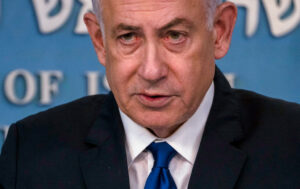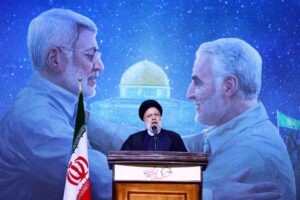Amid the continuing destruction in Gaza and the surrounding global fallout, one thing becomes ever clearer. Even as Israel’s war stutters, Iran’s broader campaign against it, and by extension what we might call the American-led order, is growing in strength.
Six months on from October 7, it’s hard to see how Israel can achieve its stated goals of dismantling Hamas and rescuing its remaining hostages. The IDF has only rescued three hostages during its ground operations in Gaza, which is a good indicator of how unrealistic the latter always was. But Hamas is also far from defeated: the terror group’s top three commanders remain at large, and its fighters are already re-emerging in areas of Gaza City that were supposedly cleared. Israel claims to have killed approximately half of its 40,000 fighters, but given the amorphous nature of the terror campaign, and the radicalising effects of Israel’s operations on the Gazan population, the notion of totally eliminating Hamas remains fanciful.
According to the February 2024 US Annual Threat Assessment report compiled by the Office of the Director of National Intelligence, Hamas will be able to continue as “lingering armed resistance… for years to come, and the military will struggle to neutralise Hamas’s underground infrastructure, which allow insurgents to hide, regain strength, and surprise Israeli forces”. And all of this for near-universal global outrage and condemnation.
Israel had not just a right but a duty to respond to the October 7 atrocities. No state could stand by and do nothing. No nation could suffer such a loss and not respond. But the events set in motion by October 7 were always going to be about more than just Israel and Gaza. A localised war has now become perhaps the primary front in a much broader conflict between the American-led order on the one hand and, on the other, a loose axis of states with little in common except a common desire to oppose that order. In the Middle East, the primary player is Iran — and it is exploiting events with sadistic ruthlessness and efficacy.
As ever, its strategy is somewhat ad hoc — especially given its own internal unrest and dying Supreme Leader — and based around opportunism as much as forethought. As ever, it also combines political and military objectives. Beyond Iran’s longstanding armed support for both Hamas and Lebanese Hezbollah, its major concern — and indeed that of Hamas and all states opposed to Israel — was the apparent integration of Israel into the Arab world following the 2020 Abraham Accords, which saw normalisation (as opposed to peace) treaties between Jerusalem and the UAE, Bahrain, Morocco, and Sudan. Next up on the diplomatic slate was an even greater prize: normalisation with the Sunni Lion and home of Islam’s two holiest sites, Saudi Arabia. The thought was simply too nauseating for Hamas or Tehran to bear, and it was their desperate desire to sabotage further Israeli-Arab rapprochement that, in part, triggered October 7.
And it worked. For the moment, the Abraham Accords are holding. But a daily stream of the most visceral suffering from Gaza is enraging Arab populaces across the Middle East. For now, there is no talk of further normalisation. The February US threat report also assessed that “Iran will seek to use the conflict in Gaza to denounce Israel, decry its role in the region, and try to dissuade other Middle Eastern states from warming ties with Israel.” It was spot on. Tehran, which had arguably been more isolated in the region than Israel, has used the war to expand its regional diplomatic relations. In November of last year, el-Sisi of Egypt and Iranian President Ebrahim Raisi had a meeting on the side of the Arab Summit in Riyadh to discuss a possible expansion of bilateral relations. Then, this February, the Iranian Minister of Foreign Affairs, Hossein Amir-Abdollahian, went on a tour of Lebanon, Syria and Qatar. Tehran is on the diplomatic offensive.
Beyond other Arab states, Iran is bringing its influence to bear on what is a key constituency for all those who oppose the US order: the imperfectly termed Global South. It has found an appreciative audience there. It was not just South Africa but also Mexico and Chile who referred “the situation of the State of Palestine” to the ICC. Taken together, states totalling 60% of the Global South’s population have either directly or indirectly supported legal action on this issue. If those who oppose the status quo are to battle it efficiently, the states once known as “non-aligned” — now, instructively, a majority of the world — will be critical in the fight ahead.
Then, of course, there is Iran’s violent military strategy. If Hamas was disappointed that the Quds Force didn’t come charging to their aid to fight the Israelis head-on (always a foolish notion), the war has highlighted the depth and scope of Iran’s capacity to mobilise its proxies. Hezbollah, the Houthis, and the Islamic Resistance in Iraq (ISI) have all combined to strike the US and its allies across the Gulf and Middle East, significantly disrupting their international commerce flows. If nothing else, Gaza has allowed Iran to show the world the potency of its “forward defence” strategy. Even though Hezbollah has not opened an all-out second front on Israel’s northern border, it continues to divert thousands of IDF soldiers, and prevents the return home of 95,000 internally displaced persons in Israel. Meanwhile, there are many in the region who see the attacks committed by ISI and others on American forces as being the catalyst for the beginning of Washington’s talks with Iraq on the withdrawal of its final 2,500 troops there — something Iran has wanted for years. Once the US pulls out fully, there is only one power who will fill that void. The result is yet another expansion of Iranian power.
Israel is fighting back. A series of strikes against Iranian targets reached a climax (for now) on Monday, when Israel droned General Mohammad Reza Zahedi and various assorted underlings. Little-known in the West, Zahedi was an important figure to Iranian regional ambitions, until recently commanding the Quds Force unit responsible for operations in Lebanon, Jordan, Syria and Palestinian territories. Inevitably, the Iranians are vowing revenge. Khamenei promised that “the evil regime will be punished by the hands of our brave men. We will make them regret this crime and others like it.” Iranian state television also reported that, because part of the Iranian embassy was struck, the attack constitutes an attack on Iran.
Iran is matching this rhetoric with moves on the ground. On Monday, Hussein Moanes, a spokesman for the Iranian-aligned militia group, Kata’ib Hezbollah, announced that the Islamic Resistance in Iraq is preparing to “equip” 12,000 “Islamic Resistance in Jordan” fighters with a significant supply of weapons so that Iraq and Jordan can jointly attack Israel to defend the Palestinian cause. It is instructive that the Iranians feel that they can openly announce the presence of a proxy in a Sunni Arab state. The Sunni Arabs have far more ideological and historical enmity with Iran than Israel does (under the Shah of Iran, Tehran and Jerusalem were allies). But these are not normal times, and Iran is exploiting this fact relentlessly. Jordan, which is in essence a Palestinian state, has witnessed tremendous unrest over the war. Since 24 March there have been near-constant protests outside the Israeli embassy in Amann. Protestors routinely chant pro-Hamas slogans and call for Jordan’s withdrawal from its 1994 peace treaty with Israel. Once more, the Iranians step gratefully in.
A presence in Jordan is of serious strategic value to Iran. It affords greater opportunity for direct strikes into Israel, which it now also surrounds with its proxies. The Islamic Resistance in Iraq has already used Jordanian airspace for drone strikes into Israel — one shot down over Irbid in northern Jordan on 12 March was believed to be targeting Ben Gurion Airport. But more than this, it will allow Iran to stir political and social unrest in the West Bank, and to move equipment and materiel more easily over the border. Compared to Hamas, terrorists in the West Bank have limited resources or capacity to attack Israel. If Iran can make a success of its Jordanian proxy, that will change.
In the meantime, new threats emerge each day. On Friday, the CIA reportedly warned Israel that Iran is planning to launch an attack with a “rain” of drones, in revenge for its strike on Zahedi. If that happens, Israel will have to respond to an attack on its territory. Iran knows this, and likely calculates that any response, no matter how justified, will be seen as yet another example of belligerence from Jerusalem.
Yet much of this has been lost beneath the noise created by the focal point of the Gaza war. This week, Britain has been in understandable uproar over the death of seven aid workers, three of whom were British nationals. Condemnation piles upon Israel at the UN. Talk of sanctions grows. Washington, once the guarantor of international security, appears unable to stop the violence on both sides. And all the while, Tehran, the Middle East’s most murderous regime, continues to exploit events to its own advantage, and our cost.
Disclaimer
Some of the posts we share are controversial and we do not necessarily agree with them in the whole extend. Sometimes we agree with the content or part of it but we do not agree with the narration or language. Nevertheless we find them somehow interesting, valuable and/or informative or we share them, because we strongly believe in freedom of speech, free press and journalism. We strongly encourage you to have a critical approach to all the content, do your own research and analysis to build your own opinion.
We would be glad to have your feedback.
Source: UnHerd Read the original article here: https://unherd.com/



